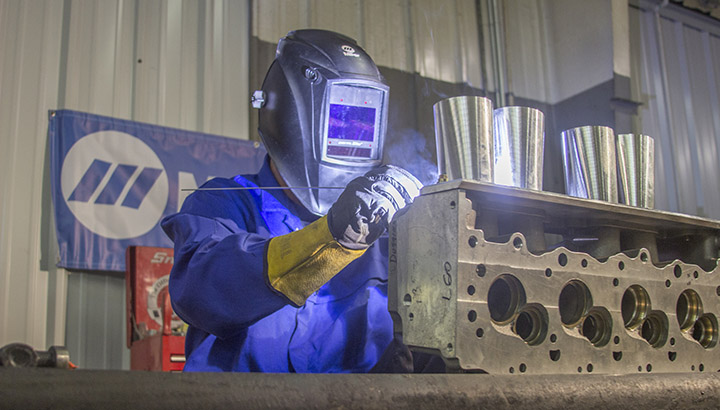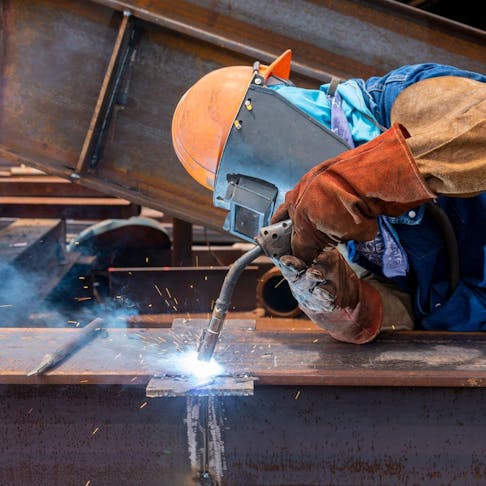Everything about Welding: Trick Insights Into Techniques and Finest Practices for Success
Welding incorporates a selection of techniques, each fit for certain products and applications. Recognizing these techniques, such as GMAW, SMAW, and TIG, is vital for accomplishing optimal results. Furthermore, the right equipment and safety techniques can not be neglected. As prep work and repairing play vital functions in the welding procedure, grasping these aspects can substantially boost the high quality of the end product. What are the key elements that assure an effective weld?
Understanding Different Welding Strategies
Welding strategies incorporate a range of techniques, each fit to specific applications and materials. Among one of the most usual methods are Gas Metal Arc Welding (GMAW), Shielded Steel Arc Welding (SMAW), and Tungsten Inert Gas Welding (TIG) GMAW, also referred to as MIG welding, is preferred for its speed and convenience, making it optimal for slim materials. SMAW, or stick welding, is favored for its simplicity and effectiveness in outdoor settings, especially with thicker steels. TIG welding provides accuracy and control, making it suitable for intricate job and non-ferrous steels (Montana Mobile Welding and Repair Fabrication). Each technique has its special benefits and factors to consider, allowing welders to pick the most effective method based upon the project's requirements, product kind, and wanted outcomes. Understanding these strategies is important for effective welding
Necessary Welding Devices and Tools
While different welding techniques call for details abilities, the best tools and devices are equally important for attaining top quality outcomes. Important welding equipment consists of welding devices, which differ depending upon the method-- such as MIG, TIG, or stick welding. Safety gear, consisting of safety helmets, aprons, and handwear covers, assurances safety and comfort throughout the procedure. Additionally, fixtures and clamps assist protect materials in area, making sure precision in welds. Consumables like welding rods, cable, and shielding gas are additionally essential elements that influence the quality of the weld. Moreover, tools such as grinders and cutters assist in surface area prep work and post-weld completing, adding to a specialist result. Investing in high-quality devices ultimately enhances the efficiency and efficiency of welding projects.
Safety Practices in Welding
Appropriate security techniques are necessary in the welding market to protect employees from possible risks. Welders should put on ideal personal safety devices (PPE), consisting of helmets with proper shading, gloves, and flame-resistant clothing. Ample air flow is crucial to lower exposure to harmful fumes and gases created throughout the welding procedure. Additionally, workers must be learnt the proper handling of welding tools to prevent mishaps. Fire safety and security steps, such as keeping combustible materials far from the welding location and having fire extinguishers readily available, are needed. Regular assessments of devices and workspaces can aid recognize prospective risks before they cause crashes. By adhering to these safety and security practices, welders can create a more secure working environment and decrease dangers linked with their profession.
Preparing Products for Welding
Preparing materials for welding is an important action that significantly influences the quality and stability of the last product (Fabrication). Appropriate prep work entails cleansing the surfaces to get rid of impurities such as dirt, oil, and rust, which can endanger the weld. Strategies such as grinding, fining sand, or using solvents are commonly used to attain a clean surface. Additionally, making certain that the materials mesh well is essential; spaces can lead to weak welds. It's likewise important to consider the positioning and positioning of the parts, as this will influence the ease of welding and the final outcome. Picking the proper filler product and making sure compatibility with the base metals is vital for achieving solid, sturdy welds.
Tips for Getting High-Quality Welds
Accomplishing high-quality welds needs interest to detail and adherence to ideal techniques throughout the welding procedure. Proper joint preparation is necessary, making certain surfaces are tidy and cost-free from impurities. Picking the proper filler product and welding method based upon the base metals is critical for suitable bonding. Maintaining constant travel speed and angle while welding can avoid issues and advertise uniformity. In addition, regulating heat input is vital; excessive heat can bring about warping and weakened joints. If required, on a regular basis evaluating the welds during the process enables for prompt adjustments. Using ideal post-weld treatments, such as cleaning and tension relief, can boost the toughness and honesty of the weld, eventually making certain an effective result.
Troubleshooting Common Welding Issues
Welding often offers difficulties that can impact the top quality and honesty of the end product. Common problems such as porosity, inconsistent weld grains, and getting too hot can emerge, each calling for specific fixing strategies. Recognizing these troubles is crucial for welders to improve their abilities and achieve perfect outcomes.
Porosity Troubles Described
Porosity can often be overlooked, it continues to be an essential problem in welding that can jeopardize the stability of a finished product. Porosity refers to the visibility of little gas pockets within the weld bead, which can compromise the joint and lead to premature failure. This problem commonly occurs from contaminants, dampness, or incorrect securing gas coverage during the welding process. To minimize porosity, welders need to confirm that the base products are tidy and dry, utilize proper securing gases, and maintain regular welding this contact form parameters. On a regular basis inspecting the equipment and setting can additionally aid identify prospective concerns before they manifest in the weld. Dealing with porosity efficiently is essential for accomplishing solid, sturdy welds that meet quality criteria.

Inconsistent Weld Beads
Irregular weld beads can greatly impact the top quality and toughness of a completed item. Numerous variables add to this issue, including improper traveling speed, inaccurate amperage settings, and irregular electrode angles. When the welder relocates too promptly, a bead may show up narrow and do not have penetration, while relocating too gradually can cause extreme accumulation. Additionally, using the incorrect amperage can lead to either undercutting or too much spatter, both of which concession weld honesty. The welder's technique, such as inconsistent torch activity, can also bring about uneven grain look. To alleviate these problems, welders need to concentrate on keeping stable, regulated motions and making sure proper tools settings to attain uniformity in their welds. Consistency is essential to accomplishing trustworthy and strong welds.
Overheating and Bending Issues
Excessive warm throughout the welding process can lead to significant overheating and warping concerns, influencing the structural stability of the workpiece. These issues often show up as distortion, which can jeopardize positioning and fit-up, making further assembly challenging. Factors adding to overheating include the selection of welding criteria, such as voltage and welding cast iron to steel take a trip rate, along with the sort of material being bonded. To alleviate these concerns, welders ought to preserve constant traveling rate and suitable heat input while keeping track of the work surface temperature. Furthermore, preheating or post-weld heat treatment can aid reduce anxieties brought on by fast cooling - Montana Mobile Welding and Repair Welding. Normal inspection and adherence to best practices are vital in preventing overheating and guaranteeing the long life and dependability of welded frameworks
Regularly Asked Concerns
What Are the Job Opportunities in the Welding Sector?
The welding sector uses diverse career opportunities, consisting of settings as welders, assessors, instructors, and engineers. Professionals can operate in manufacturing, building and construction, aerospace, and automobile markets, profiting from strong demand and affordable salaries in different roles.
Just How Can I Improve My Welding Rate Without Compromising Top Quality?
To improve welding speed without compromising top quality, one should exercise effective techniques, keep tools, optimize setups, and boost hand-eye control. Normal find more information training and looking for feedback can also substantially add to achieving quicker, high-grade welds.
What Qualifications Are Available for Welders?
Numerous accreditations exist for welders, consisting of those from the American Welding Society (AWS), the National Facility for Construction Education and Research Study (NCCER), and various industry-specific organizations. These qualifications improve employability and demonstrate skill efficiency.
How Does Welding Impact the Features of Metals?
Welding affects the residential properties of steels by modifying their microstructure, which can result in adjustments in ductility, hardness, and strength. Warm input and cooling rates throughout the process substantially affect these material qualities.
Can I Bonded Dissimilar Metals With Each Other?
